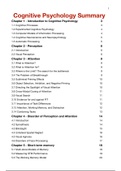Summary
Cognitive Psychology - Summary
- Course
- Institution
- Book
This is a compact 50-page summary of the book "An introduction to cognitive psychology" by David Groome. The Summary also includes the most important aspects of the lectures of the course 'Cognitive Psychology'.
[Show more]




